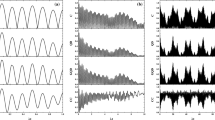Abstract
In this article, we present the analytical solution for the pair of entangled two three-level atoms in the cascade configuration with and without the atomic motion effect. The effects of time dependent coupling and photon multiplicity on the evolution of the nonlocal correlation between the two atoms are examined. It is shown that the amount of atom-atom entanglement increases for one photon transition when the atomic motion effect is considered. Also, the entanglement between the two atoms decreases by increasing the photons multiplicity when the time dependent coupling effect is ignored. Finally, the results explored very important phenomena such as entanglement sudden death and entanglement sudden birth.




Similar content being viewed by others
References
Sete, E.A., Svidzinsky, A.A., Eleuch, H., Yang, Z., Nevels, R.D., Scully, M.O.: J. Mod. Opt. 57, 1311 (2010)
Benenti, G., Casati, G., Strini, G.: Principles of quantum computation and information, volume II: basic tools and special topics. World Scientific, Singapore City (2007)
Nielsen, M.A., Chuang, I.L.: Quantum Computation and Quantum Information 10th Anniversary Edition. Cambridge University Press, Cambridge (2010)
Ekert, A.: Phys. Rev. Lett. 67, 661 (1991)
Cirac, J.I., Gisin, N.: Phys. Lett. A 229, 1 (1997)
Fuchs, C.A., Gisin, N., Griffiths, R.B., Niu C.-S., Peres, A.: Phys. Rev. A 56, 1163 (1997)
Stallings, W.: Cryptography and Network Security: Principles and Practice, 6th edn. Prentice Hall (2013)
Bennett, C.H., Brassard, G., Crepeau, C., Jozsa, R., Peres, A., Wootters, W.K.: Phys. Rev. Lett. 70, 1895 (1993)
Weisbuch, C., Nishioka, M., Ishikawa, A., Arakawa, Y.: Phys. Rev. Lett. 69, 3314 (1992)
Savona, V., Hadril, Z., Quattropani, A.: Phy. Rev. B 49, 877 (1994)
Eleuch, H.: Int. J. Mod. Phys. B 24, 5653 (2010)
Obada, A.S. -F., Abdel-Khalek, S.: Physica A 389, 891 (2010)
Abdel-Khalek, S., Nofal, T.A.: Physica A 390, 2626 (2011)
Obada, A.S.-F., Abdel-Khalek, S., Plastino, A.: Physica A 390, 525 (2011)
Abdel-Khalek, S.: Quantum Inf. Process. 12, 3761 (2013)
Obada, A., Abdel-Khalek, S., Berrada, K., Shaheen, M. .: Physica A 392, 6624 (2013)
Mancini, S., Giovannetti, V., Vitali, D., Tombesi, P.: Phys. Rev. Lett. 88, 120401 (2002)
Zhang, J., Peng, K., Braunstein, S.L.: Phys. Rev. A 68, 013808 (2003)
Pinard, M., Dantan, A., Vitali, D., Arcizet, O., Briant, T., Heidmann, A.: Europhys. Lett. 72, 747 (2005)
Huang, S., Agarwal, G.S.: New J. Phys. 11, 103044 (2009)
Sete, E.A., Eleuch, H.: Phys. Rev. A 89, 013841 (2014)
Sete, E.A., Eleuch, H., Ooi, C.R.: J. Opt. Soc. Am. B 31, 2821 (2014)
Yu, T., Eberly, J.H.: Science 323, 598 (2009)
Yonace, M., Yu, T., Eberly, J.H.: J. Phys. B: At. Mol. Opt. Phys. 39, S621 (2006)
Yonac, M., Eberly, J.H.: Phys. Rev. A 82, 022321 (2010)
Joshi, Lawande, S.V.: Phys. Rev. A 48, 2276 (1993)
Abdel-Khalek, S.: Open. Syst. Inf. Dyn. 22, 1550015 (2015)
Bose, S., Fuentes-Guridi, I., Knight, P.L., Vedral, V.: Phys. Rev. Lett. 87, 050401 (2001)
Iwasawa, H., Matsuo, K.: Opt. Commun. 117, 550 (1995)
Ng, K.M., Lo, C.F., Liu, K.L.: Eur. Phys. J. D 6, 119 (1999)
Travěnec, I.: Phys. Rev. A 85, 043805 (2012)
Singh, S.: Int. J. Theor. Phys. 51, 838 (2012)
Eleuch, H., Rostovtsev, Y.V., Scully, M.O.: EPL 89, 50004 (2010)
Manasreh, O.: Semiconductor heterojunctions and nanostructures. McGraw-Hill Professional, New York (2005)
Levine, R.D.: Quantum mechanics of molecular rate processes. Dover Publications, New York (1999)
Schleich, W.P.: Quantum optics in phase space. WILEY-VCH, Berlin (2001)
Peres, A.: Phys. Rev. Lett. 77, 1413 (1996)
Horodecki, P.: Phys. Lett. A 232, 333 (1997)
Fujii, K., Higashida, K., Kato, R., Suzuki, T, Wada, Y.: arXiv:quant-ph/0403008 (2004)
Eleuch, H., Gu ´erin, S., Jauslin, H.R.: Phys. Rev. A 85, 013830 (2012)
Author information
Authors and Affiliations
Corresponding author
Appendix A
Appendix A
In order to clarifying the derivations of (5) (i.e. the unitary operator) let us defined
By product |1〉 column vector into row vector 〈1| we get the first matrix element
as for as |i〉 〈j| = {.S ii ifi = jS ij ifi≠j, i, j = 1, 2, 3. Therefor, we can rewrite the total Hamiltonian in (1) as follows
In order to study the atoms A-B entanglement we must find the total wave function \(|{\Psi }_{tot}\left (t\right ) \rangle \) and for more simplicity, we will calculate the unitary operator for the first atom A by using the Hamiltonian interaction as follows
where the normalization condition is satisfy \(\left [ \hat {H}_{I}^{A},\hat {H}_{I}^{B}\right ] =0,\) i.e. \(\hat {H}_{I}^{A}\) and \(\hat {H}_{I}^{B}\) are commute. Thus, the time-dependence Schrödinger wave equation is [39]
This is unitary operator for the atom A, consider
hence
where
and D is the diagonal matrix. Now, we can generalized the diagonal matrix as follows [39]
Now, we can rewrite \(U_{1}\left (t\right ) \) as follows
thus
Rights and permissions
About this article
Cite this article
Abdel-Khalek, S., A. Halawani, S.H. & Obada, AS.F. Effect of Time Dependent Coupling on the Dynamical Properties of the Nonlocal Correlation Between Two Three-Level Atoms. Int J Theor Phys 56, 2898–2910 (2017). https://doi.org/10.1007/s10773-017-3457-9
Received:
Accepted:
Published:
Issue Date:
DOI: https://doi.org/10.1007/s10773-017-3457-9




